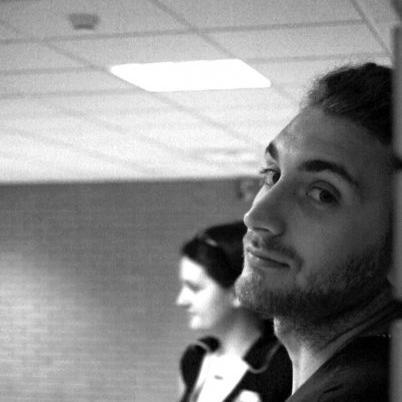
Andrea Santoro
@andreasantor0
Followers
658
Following
3K
Media
43
Statuses
895
Complex Networks - Neuroscience Researcher @ CENTAI
Turin, Italy
Joined March 2013
🧠 Want to understand how different higher-order methods compare in brain connectivity analysis? Check out our new preprint — a fantastic collab with past & present @NPLab_ members: 🔗 https://t.co/T9GGlVPpn1
2
15
47
Ten years (!) after submitting the grant, NextBrain is published in @Nature . NextBrain is a brain atlas built from 3D histology that enables segmentation of 3D brain scans (MRI, Hip-CT, even photos!) into hundreds of regions. Article, data, code, videos, & more in this 🧵 (1/3)
7
86
373
Excited to share that our paper is out in PLOS Computational Biology! 🚀 🔗 https://t.co/DlEI4RnTXr Joining forces between two fantastic laboratories @NPLab_ @ConnectomeLab 🔥
journals.plos.org
Author summary Transcranial ultrasound stimulation (TUS) offers a non-invasive approach to modulating brain activity, holding promise for treating psychiatric and neurological disorders. Despite its...
Could high-order interactions help us understand the network plasticity mechanisms underlying ultrasound neuromodulation? 🧠 Joining forces between two fantastic laboratories @NPLab_ @ConnectomeLab Check out our preprint for insights! 🧵(1/N) 👇 https://t.co/ZXRdF2FetD
0
4
12
New paper now out in Physics Report: If you're interested in information theory, complex systems, and emergent properties, this is the paper for you: a comprehensive review paper designed to bring anyone up to speed on information theory for complex systems scientists.
17
134
726
Latest work at #EUSIPCO25!🚀 We bring Topological Signal Processing to the brain 🧠 — showing that edge-based approaches outperform classical GSP in task decoding. Great collab with @MarcoNurisso & @lordgrilo Paper👉 https://t.co/EQlp5JknnP
#Neuroimaging #SignalProcessing #TSP
0
3
10
I can't believe it's out! 🎉 "Accurate and Interpretable Prediction of Antidepressant Treatment Response from Receptor-informed Neuroimaging" https://t.co/Zzx5WkvxJA Thanks to the awesome co-authors @loopyluppi @lawn_tim @LeorRoseman @ProfDavidNutt @RCarhartHarris @PedroMediano
0
5
27
🚨 Two new papers from us @NPLab_ offer a deep dive into the topological and higher-order structure of brain function. Together, they chart a unified view of how the brain encodes identity and computation beyond pairwise interactions.
1
11
21
Huge thanks for this fun collaboration to past and present members of the NPLab — @matte_blacks, @simonepoetto , @DavideOrsenigo , Matteo Diano, @GaticaMarilyn , @lordgrilo 🙌🧠
0
1
3
14/ This work takes an important step toward a unified roadmap for navigating the complex, fragmented landscape of higher-order brain connectivity.
1
1
1
13/ In short: ✅ HOIs provide richer, biologically grounded insights into brain function ✅ The research landscape is now organized — synergy, redundancy, topology ✅ HOIs better capture traits; FC better captures states ✅ Tools are available for broader use (HOI codes)
1
1
2
12/ One standout: topological scaffolds. They act as integrators — capturing synergy in nodes, and structure-function coupling at edges. They’re central in linking connectivity patterns to behavior.
1
1
1
11/ Even dopamine levels relate: lower dopamine = more flexible task-related reconfiguration.
1
1
1
10/ HOIs also help explain how the brain reconfigures during different tasks. Social/emotional tasks show more synergy, while sensorimotor ones lean on redundancy.
1
1
1
9/ This shows a key trade-off: 🔍 If you want to understand who a person is (trait-level): use HOIs ⚡ If you want to know what they’re doing (state-level): FC is often enough
1
1
1
8/🧠 For task decoding, though, classic FC is still one of the top methods.
1
0
1
@NPLab_ @matte_blacks @simonepoetto @GaticaMarilyn @lordgrilo 7/ When it comes to applications, HOIs show their power: 🎯 For brain fingerprinting (ID'ing individuals), HOI metrics outperform classical functional connectivity (FC)
1
2
2
@NPLab_ @matte_blacks @simonepoetto @GaticaMarilyn @lordgrilo 6/ But there’s more. These metrics also reflect the brain’s neurochemistry: •Redundant metrics correlate with metabolic maps •Synergistic & topological metrics align with receptor distributions
1
2
1
@NPLab_ @matte_blacks @simonepoetto @GaticaMarilyn @lordgrilo 5/ Despite different math, rank differences of all HOI metrics align with the brain's core hierarchy: from sensory (unimodal) to associative (transmodal) cortex. This “HOI axis” reflects fundamental computational principles embedded in the brain’s layout. 🧭
1
2
1
@NPLab_ @matte_blacks @simonepoetto @GaticaMarilyn @lordgrilo 4/ First big insight: HOI metrics fall into 3 categories: 🔴 Redundant: capture overlapping info (e.g., within sensory networks) 🔵 Synergistic: capture integrative info (e.g., across systems) 🟣 Topological: bridge the two, identifying mesoscale structures
1
2
1
@NPLab_ @matte_blacks @simonepoetto @GaticaMarilyn @lordgrilo 3/ Yet with all these new tools — PhiID, O-information, PED, persistent homology, triangles, scaffolds — no one knew how they compared, what they captured, or when to use which. This paper tackles this directly with a comprehensive comparison across 10 HOI metrics.
1
2
1
@NPLab_ @matte_blacks @simonepoetto @GaticaMarilyn @lordgrilo 2/ Brain models often focus on pairs of regions, but real interactions might involve groups acting together HOI methods aim to capture this, from detecting synergy and redundancy using different information-theoretic approaches to mapping topological cycles in brain networks.
1
2
1






